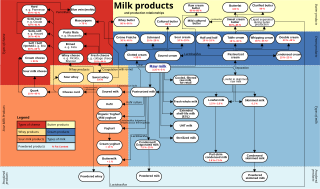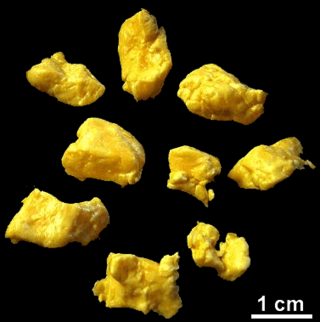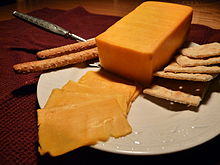
Cheddar cheese is a natural cheese that is relatively hard, off-white, and sometimes sharp-tasting. Cheddar originates from the English village of Cheddar in Somerset.

Dairy products or milk products, also known as lacticinia, are food products made from milk. The most common dairy animals are cow, water buffalo, nanny goat, and ewe. Dairy products include common grocery store food items in the Western world such as yogurt, cheese, milk and butter. A facility that produces dairy products is known as a dairy. Dairy products are consumed worldwide to varying degrees. Some people avoid some or all dairy products either because of lactose intolerance, veganism, or other health reasons or beliefs.
Pinconning cheese is an aged semi-hard whole cow's milk, Colby-style cheese named after Pinconning, Michigan. It is made and distributed by Pinconning Cheese Company and Wilson's (Horn) Cheese Shoppe in Pinconning, Michigan.

Monterey Jack, sometimes shortened to Jack, is a US white, semi-hard cheese made using cow's milk, with a mild flavor and slight sweetness. It has been called "an American original" and "as a vestige of Spanish rule in the early nineteenth century, derives from a Franciscan monastic style of farmer's cheese."

Curd is obtained by coagulating milk in a sequential process called curdling. It can be a final dairy product or the first stage in cheesemaking. The coagulation can be caused by adding rennet, a culture, or any edible acidic substance such as lemon juice or vinegar, and then allowing it to coagulate. The increased acidity causes the milk proteins (casein) to tangle into solid masses, or curds. Milk that has been left to sour will also naturally produce curds, and sour milk cheeses are produced this way. Producing cheese curds is one of the first steps in cheesemaking; the curds are pressed and drained to varying amounts for different styles of cheese and different secondary agents are introduced before the desired aging finishes the cheese. The remaining liquid, which contains only whey proteins, is the whey. In cow's milk, 90 percent of the proteins are caseins. Curds can be used in baking or may be consumed as a snack.

Cheese curds are moist pieces of curdled milk, eaten either alone or as a snack, or used in prepared dishes. They are most often consumed throughout the northern United States and Canada. Notably, cheese curds are popular in Quebec, as part of the dish poutine, and in Wisconsin and Minnesota where they can be served breaded and deep fried. Curds are sometimes referred to as "squeaky cheese" or fromage en crottes.

Processed cheese is a food product made from cheese and unfermented dairy ingredients mixed with emulsifiers. Additional ingredients, such as vegetable oils, salt, food coloring, or sugar may be included. As a result, many flavors, colors, and textures of processed cheese exist. Processed cheese typically contains around 50 to 60% traditional cheese.

Cheesemaking is the craft of making cheese. The production of cheese, like many other food preservation processes, allows the nutritional and economic value of a food material, in this case milk, to be preserved in concentrated form. Cheesemaking allows the production of the cheese with diverse flavors and consistencies.

Modern American cheese is a type of processed cheese developed in the 1910s made from cheddar, Colby, or similar cheeses. It is mild with a creamy and salty flavor, has a medium-firm consistency, and has a low melting point. It is typically yellow or white in color; yellow American cheese is seasoned and colored with annatto.
The manufacture of Cheddar cheese includes the process of cheddaring, which makes this cheese unique. Cheddar cheese is named for the village of Cheddar in Somerset in South West England where it was originally manufactured. The manufacturing of this cheese has since spread around the world and thus the name has become generically known.

Colby-Jack, or Co-jack/Cojack, is an American cheese made from Colby and Monterey Jack. It is classified as semi-hard in texture and is mild due to its two-week aging process. It is generally sold in a full-moon or a half-moon shape when it is young. The flavor of Colby-Jack is mild to mellow. Colby-Jack cheese is mainly produced in the states of Wisconsin and California. It is used in various dishes or as a topping to be melted. These dishes include burgers, pasta bakes, macaroni and cheese, casseroles and so on. It is predominantly used in the United States, and is not readily available internationally.

Sulguni is a brined Georgian cheese from the Svaneti and Samegrelo regions. It has a sour, moderately salty flavor, a dimpled texture, and an elastic consistency; these attributes are the result of the process used, as is the source of its nickname "pickle cheese". Its color ranges from white to pale yellow. Sulguni is often deep-fried, which masks its odor. It is often served in wedges.

Cheese is a dairy product produced in wide ranges of flavors, textures, and forms by coagulation of the milk protein casein. It comprises proteins and fat from milk. During production, milk is usually acidified and either the enzymes of rennet or bacterial enzymes with similar activity are added to cause the casein to coagulate. The solid curds are then separated from the liquid whey and pressed into finished cheese. Some cheeses have aromatic molds on the rind, the outer layer, or throughout.

Granular cheese, also known as stirred curd cheese and hard cheese, is a type of cheese produced by repeatedly stirring and draining a mixture of curd and whey. It can refer to a wide variety of cheeses, including the grana cheeses such as Parmigiano-Reggiano (pictured) and various others. Many types are commonly used in the production of processed cheese, especially American cheese, which by law must consist of Cheddar cheese, Colby cheese, cheese curd, or granular cheese.

There are many different types of cheese. Cheeses can be grouped or classified according to criteria such as length of fermentation, texture, methods of production, fat content, animal milk, and country or region of origin. The method most commonly and traditionally used is based on moisture content, which is then further narrowed down by fat content and curing or ripening methods. The criteria may either be used singly or in combination, with no single method being universally used.

Beecher's Handmade Cheese is an artisan cheesemaker and retail shop with locations in the Pike Place Market, Seattle, Washington and New York City's Flatiron District. The company was founded by Kurt Beecher Dammeier in 2003 and opened in the Pike Place Market after Dammeier obtained a difficult to obtain storefront lease in the Market. Because Dammeier had never been a cheesemaker, he sought out the assistance of Brad Sinko, who helped run a family cheese-making business in Oregon. A second location was opened in 2011 in the Flatiron neighborhood of Manhattan in New York City.

Marble cheese is a name given to cheeses with marbled patterns. These are produced by combining either two different colored curds, cheese curds or processed cheeses.

Dairy is a major industry in the state of Wisconsin. Being known for its dairy production, the state is often called "America's Dairyland." The industry is prominent in official state symbols—being displayed on the state's license plates, state's slogan, and on the state quarter.

Commercial cheesemaking in Wisconsin dates back to the nineteenth century. Early cheesemaking operations began on farmsteads in the Michigan and Wisconsin territories, with large-scale production starting in the mid-1800s. Wisconsin became the largest producer of cheese in the United States in the early 1900s, and in 2019 produced more than 3.36 billion pounds of cheese of more than 600 varieties, accounting for 26% of all cheese made in the country that year.




















